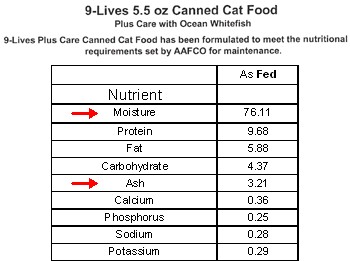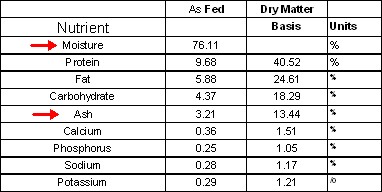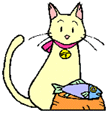Feline Nutrition: The Right Food
Obviously, the right food for Fluffy is one that’s good for her nutritionally, and one that she’ll eat. We’re going shopping today, but before you fire up the Lamborghini, let’s lay things out sensibly and take this a step at a time. First of all, there are hundreds upon hundreds of foods available, but that’s okay. We don’t understand the mumbo-jumbo on those can labels, but that’s okay too;
we will by the end of this article. Let’s first establish Fluffy’s basic feeding protocol: Is she obese? If so, we’ll be looking only at foods that are lower in fats and carbohydrates? Does she have an ailment? If so, we’ll ignore foods that are not designed specifically for that purpose. What’s her favorite type of food.Chicken? Beef? Fish? We’ll assume that Fluffy prefers canned food, but it wouldn’t matter; the process is the same. Now, get the phone book and look under “Pet Supplies & Foods” or a similar heading. Jot down the addresses for any pet-food stores; most areas will have at least one or two. Okay, we’re ready; grab your jacket and let’s go. You can drive; I’m afraid of fast cars.
“Where do we go first?” you ask. Assuming Fluffy has no ailments, we’ll hit the supermarkets first, and while we’re driving, let’s talk about can labels. We’ll see plenty of them today, so let’s go over the advantages and disadvantages. Can labels show us the ingredients in descending order, with the most prominent ingredient being the first on the list. Don’t be shocked to see “water” or “moisture” as the first one; most canned foods are 70 – 80% water. The can label also shows us the Guaranteed Analysis, which shows us minimum and maximum values for certain elements (fats, water, protein, etc). So.the information on can labels is valuable. We can, for instance, immediately eliminate foods that are high in ash, fats, carbs, fillers, and so on.
Hey, there’s Shop ‘N’ Go.let’s go see what we can find. And by the way: Our goal is only to gather a variety of potentially suitable foods, so we’ll get the smallest cans available, okay? In we go, and we’re going t just browse them all first, to get a “feel” for the basics: Fats, carbs, ash, protein, and so on. We’ll look at Alpo, Friskie’s, Purina, Iams.whatever they have. Then we’ll go back through the aisle again and pick out those that we think might prove out to be okay, and that we think Fluffy might like. Let’s refresh our memory: Of course we know that meat is better than by-product, but let’s not discount a potentially good food because of just that, okay? Truth is, by-products and “meal” are not poison. If ash, for example –or maybe fats– are higher than everything else you’ve looked at, then set it back on the shelf; it’s not worth pursuing. But if the first real ingredient is meat by-product, and the rest of it seems to be in line with our other considerations, set it in the basket. “Where to next?” you ask as we leave the checkout counter. Another supermarket, and then the pet-food stores. And please drive a little s-s-slower this time. Okay.you know what we’re doing now. We’ll spend a few bucks, but not many, and nothing will be wasted. Those foods that Fluffy doesn’t like, and those foods that we ultimately find are nutritionally unsuitable, will be set outside in the back yard overnight.and I pretty much guarantee you that some lucky kitty will benefit from our research.
Okay, we made it back home right-side-up.whew! Now we take each of those cans we bought, and jot down the 1-800 number from each label. Next, we call each number and ask them for the Nutrient Reference Chart for their canned foods. If they ask “which one?” say: “Gosh, my kitty LOVES your food, but I’m not sure which she loves the best! Please send me all that you can.” You may also be asked: “Do you want the as-fed sheets, or the dry-weight-analysis?” We’ll cover that in just a minute, but for now, tell them “Dry-weight if you have them, but it doesn’t matter.”
“Umm.why do we want these nutrient reference charts?” Because the can label didn’t tell us what we need to know. It gave us the ability to sort out the potentially-good from the obvious-bad, but it didn’t give us the details we’re after. The label told us, for example, that the product contains no more than 1.9% ash, but what, exactly, is 1.9% ash? And how does that value (once I know what it really is) compare to other foods? It told us that potassium is the 4th ingredient in the list, but it didn’t tell us how much potassium is in that food. The nutrient reference charts will tell us all of that.
(CLICK HERE to see an actual example).
So we wait for the mailman to deliver our charts, and expect it to take a couple of weeks.
Shown below is a cut-out from a real one: (Note the red pointers for Moisture and Ash).we’ll use those two values for this exercise.

Ah, here we are, finally! Now we can tell exactly how much of every nutrient is in this food, so that we can compare with other foods! Notice that this can of food is 76.06% moisture. That tells us that the analysis was done using the as-fed method.as-fed simply means everything in the can, including the water. Note that 3.21% of this product is Ash, according to the chart. However, that value is somewhat misleading, because it’s really saying that ash is 3.21% of the whole can, which is mostly water! We still don’t know how much ash is actually in this food, but we will momentarily. In order to determine the actual (true) quantity of ash, we need to subtract the water and re-calculate the as-fed value to come up with the dry-weight values. And guess what? I’ve created a handy-dandy calculator to do just that! Below is another cut-out from the same chart, and this manufacturer happens to show both as-fed and dry-weight values; most do not. You’ll see below that that seemingly low 3.21% ash is really 13.44% of the dry-matter left in the can when we removed the water from our calculations! That’s quite a difference.

So.all of this was about getting down to the dry-weight measure of what’s in a cat food. Why is that so important? Because the dry-weight measure is the actual quantity of a given nutrient, and that’s the only real value that counts. Why so? Well, if we put 100 grains of sugar in a teacup of water, or in a quart of water, and then drank the whole thing, we’d still be ingesting those 100 grains of sugar. Problem is, we already know we started with 100 grains of sugar here, but in a can of food where the measurements are done using as-fed calculations (or from a can label), we do not know the quantity. And in order to do accurate comparisons, we must have that dry-weight value of the crucial nutrients.
What are the crucial nutrients? There are many, but I pay close attention to the ones you’ll see on the calculator. Go ahead and CLICK HERE to play around with it; use the values from above to see it work. It was created for you, so that you don’t have to do the math, and so that you, too, can discover what’s really in that can of food!
“Does it really make that much difference?” Oh, yes! Some cat foods are as low as 70% water, and I’ve seen some as high as 82% water. Use the calculator, plug in the 3.21% ash, and then change the moisture water value from 70% to 82% and watch what happens.a percentage increase of greater than 75% of ash content as related to the rest of the dry matter! WHOA!
And most importantly.go do your shopping, and get those Nutrient Reference Charts in the mail and on the way to you!
Nutrition Calculator
This is an Excel Spreadsheet and requires that you have Microsoft Excel loaded on your computer to run.
Disclaimer: Kathy Fatheree is not at all a medical expert. Contents of this web site are a collection of Kathy’s assist feeding experiences as well as the experiences of other cat owners who have assist fed their cats. While every effort has been made to ensure the accuracy of the information, Kathy Fatheree or anyone associated with this web site cannot be held responsible for anything that may happen as a result of using the information on this site.
